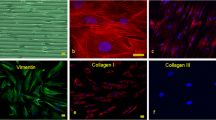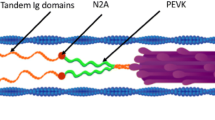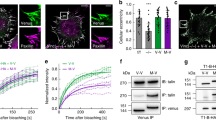Summary
Junctional microfibrils, which span the lamina lucida of the vertebrate myotendinous junction, are thought to function in force transmission at the junction. This hypothesis has been tested by disrupting junctional microfibrils through elimination of extracellular divalent cations, and determining the effects of this treatment on the ultrastructure and mechanics of whole frog skeletal muscles passively stretched to failure. Muscles incubated in divalent cation-free solution failed exclusively in the lamina lucida of the myotendinous junction, while control muscles all failed within the muscle fibres, several millimetres away from the junction. Failure sites from divalent cation-free muscles incubated with antibodies against collagen type IV, laminin, and tenascin showed no labelling of the avulsed ends of the muscle fibres, indicating that remnants of junctional microfibrils observed on the cell surface are not composed of any of these extracellular proteins. All three proteins were present on the tendon side of the failure site, confirming that the lamina densa remains attached to the tendon. Breaking stress for control muscles was 3.47×105 N m-2, and for divalent cation-free muscles, 1.84×105 N m-2, or approximately half the control value. Breaking strain averaged 1.17 for divalent cation-free muscles and 1.39 for controls, although the difference was not significant. We conclude that junctional microfibrils are components of a divalent cation-dependent adhesion mechanism at the myotendinous junction. In addition, ultrastructural analysis of divalent cation-free fibres stretched just short of failure suggests that a second, divalent cation-independent mechanism persists along the non-junctional cell surface, and can transmit substantial passive tension from myofibrils laterally to the extracellular matrix, bypassing the failed myotendinous junction.
Similar content being viewed by others
References
AJIRI, T., KIMURA, T., ITO, R. & INOKUCHI, S. (1978) Microfibrils in the myotendon junctions. Acta Anat. 102, 433–9.
ALMEKINDERS, L. C. & GILBERT, J. A. (1986) Healing of experimental muscle strains and the effects of nonsteroidal antiinflammatory medication. Am. J. Sports Med. 14, 303–8.
BJERKNES, M. & CHENG, H. (1981) Methods for the isolation of intact epithelium from the mouse intestine. Anat. Rec. 199, 565–74.
BOZYCZKO, D., DECKER, C., MUSCHLER, J. & HORWITZ, A. F. (1989) Integrin on developing and adult skeletal muscle. Exp. Cell Res. 183, 72–91.
BUCHTHAL, F. & KNAPPEIS, G. G. (1940) Diffraction spectra and minute structure of the cross-striated muscle fibre. Skand. Archiv. 83, 281–307.
BURRIDGE, K. & MANGEAT, P. (1984) An interaction between vinculin and talin. Nature 308, 744–6.
CASELLA, C. (1950) Tensile force in total striated muscle, isolated fibre and sarcolemma. Acta Physiol. Scand. 21, 380–401.
CHIQUET, M. & FAMBROUGH, D. M. (1984) Chick myotendinous antigen. I. A monoclonal antibody as a marker for tendon and muscle morphogenesis. J. Cell Biol. 98, 1926–36.
CREVEY, B. J., LANGER, G. A. & FRANK, J. S. (1978) Role of Ca2+ in maintenance of rabbit myocardial cell membrane structural and functional integrity. J. Mol. Cell. Cardiol. 10, 1081–100.
ELLISON, J. & GARROD, D. R. (1984) Anchoring filaments of the amphibian epidermal-dermal junction traverse the basal lamina entirely from the plasma membrane of hemidesmosomes to the dermis. J. Cell Sci. 72, 163–72.
ENGVALL, E. & PERLMANN, P. (1972) Enzyme-linked immunosorbent assay, ELISA. J. Immunol. 109, 129–35.
FRANK, J. S., LANGER, G. A., NUDD, L. M. & SERAYDARIAN, K. (1977) The myocardial cell surface, its histochemistry, and the effect of sialic acid and calcium removal on its structure and cellular ionic exchange. Circ. Res. 41, 702–14.
FRANK, J. S., RICH, T. L., BEYDLER, S. & KREMAN, M. (1982) Calcium depletion in rabbit myocardium. Ultrastructure of the sarcolemma and correlation with the calcium paradox. Circ. Res. 51, 117–30.
GARRETT JR., W. E. (1983) Strains and sprains in athletes. Postgrad. Med. 73, 200–9.
GARRETT JR., W. E. & TIDBALL, J. G. (1988) Myotendinous junction: structure, function, and failure. In Injury and Repair of the Musculoskeletal Soft Tissues (edited by Woo, S. L-Y. & Buckwalter, J. A.) pp. 171–207. Park Ridge, American Academy of Orthopaedic Surgeons.
GARRETT JR., W. E., SAFRAN, M. R., SEABER, A. V., GLISSON, R. R. & RIBBECK, B. M. (1987) Biomechanical comparison of stimulated and nonstimulated skeletal muscle pulled to failure. Am. J. Sports Med. 15, 448–54.
GARRETT JR., W. E., NIKOLAOU, P. K., RIBBECK, B. M., GLISSON, R. R. & SEABER, A. V. (1988) The effect of muscle architecture on the biomechanical failure properties of skeletal muscle under passive extension. Am. J. Sports Med. 16, 7–12.
GEIGER, B. (1979) A 130 K protein from chicken gizzard: its localization at the termini of microfilament bundles in cultured chicken cells. Cell 18, 193–205.
GIBRALTER, D. & TURNER, D. C. (1985) Dual adhesion systems of chick myoblasts. Dev. Biol. 112, 292–307.
HANAK, H. & BOCK, P. (1971) Die feinstruktur der muskel-sehnenverbindung von skelett- und herzmuskel. J. Ultrastruc. Res. 36, 68–85.
HSU, S. M., RAINE, L. & FANGER, H. (1981) A comparative study of the peroxidase-antiperoxidase method and an avidinbiotin complex method for studying polypeptide hormones with radioimmunoassay antibodies. Am. J. Clin. Pathol. 75, 734–8.
ISHIKAWA, H. (1965) The fine structure of myo-tendon junction in some mammalian skeletal muscles. Arch. Histol. Jap. 25, 275–96.
KLEBE, R. J. (1974) Isolation of a collagen-dependent cell attachment factor. Nature 250, 248–51.
KLEBE, R. J., HALL, J. R., ROSENBERGER, P. & DICKEY, D. (1977) Cell attachment to collagen: the ionic requirements. Exper. Cell Res. 110, 419–25.
KORNELIUSSEN, H. (1973) Ultrastructure of myotendinous junctions in Myxsine and rat: specializations between the plasma membrane and the lamina densa. Z. Anat. Entwick.-Gesch. 142, 91–104.
KYHSE-ANDERSEN, J. (1984) Electroblotting of multiple gels: a simple apparatus without buffer tank for rapid transfer of proteins from polyacrylamide to nitrocellulose. J. Biochem. Biophys. Meth. 10, 203–9.
LIGHTNER, V. A., GUMKOWSKI, F., BIGNER, D. D. & ERICKSON, H. P. (1989) Tenascin/hexabrachion in human skin: biochemical identification and localization by light and electron microscopy. J. Cell Biol. 108, 2483–93.
LOFTUS, J. C., O'TOOLE, T. E., PLOW, E. F., GLASS, A., FRELINGER, A. L. & GINSBERG, M. H. (1990) A β3 integrin mutation abolishes ligand binding and alters divalent cation-dependent conformation. Science 249, 915–18.
MACKAY, B., HARROP, T. J. & MUIR, A. R. (1969) The fine structure of the muscle tendon junction in the rat. Acta Anat. 73, 588–604.
MAGID, A. & LAW, D. J. (1985) Myofibrils bear most of the resting tension in frog skeletal muscle. Science 230, 1280–2.
MAGID, A., TING-BEALL, H. P., CARVELL, M., KONTIS, T. & LUCAVECHE, C. (1984) Connecting filaments, core filaments, and side-struts: a proposal to add three new load-bearing structures to the sliding filament model. In Contractile Mechanisms in Muscle (edited by Pollack, G. H. & Sugi, H.), pp. 307–28. New York, Plenum Publishing Corp.
MAIR, W. G. P. & TOME, F. M. S. (1972) The ultrastructure of the adult and developing human myotendinous junction. Acta Neuropath. (Berlin) 21, 239–52.
MILLER, W. A. (1977) Rupture of the musculotendinous juncture of the medial head of the gastrocnemius muscle. Am. J. Sports Med. 5, 191–3.
MUIR, A. R. (1967) The effects of divalent cations on the ultrastructure of the perfused rat heart. J. Anat. 101, 239–61.
NAKAO, T. (1975) Fine structure of the myotendinous junction and ‘terminal coupling’ in the skeletal muscle of the lamprey, Lampetra japonica. Anat. Rec. 182, 321–38.
NAKAO, T. (1976) Some observations on the fine structure of the myotendinous junction in myotoma muscles of the tadpole tail. Cell Tiss. Res. 166, 241–54.
OAKES, B. W. (1984) Hamstring muscle injuries. Aust. Fam. Phys. 13, 587–91.
PARDO, J. V., SILICIANO, J. D. & CRAIG, S. W. (1983) A vinculin-containing cortical lattice in skeletal muscle: transverse lattice elements (‘costameres’) mark sites of attachment between myofibrils and sarcolemma. Proc. Natl. Acad. Sci. USA 80, 1008–12.
PIEROBON-BORMIOLI, S. (1981) Transverse sarcomere filamentous systems: ‘Z- and M-cables’. J. Muscle Res. Cell Motil. 2, 401–13.
PODOLSKY, R. J. (1964) The maximum sarcomere length for contraction of isolated myofibrils. J. Physiol. 170, 110–23.
PYTELA, R., PIERSCHBACHER, M. D., ARGRAVES, S., SUZUKI, S. & RUOSLAHTI, E. (1987) Arginine-glycine-aspartic acid adhesion receptors. Method Enzymol. 144, 475–89.
RAPOPORT, S. I. (1972) Mechanical properties of the sarcolemma and myoplasm in frog muscle as a function of sarcomere length. J. Gen. Physiol. 59, 559–85.
RAPOPORT, S. I. (1973) the anisotropic elastic properties of the sarcolemma of the frog semitendinosus muscle fiber. Biophys. J. 13, 14–36.
REEDY, M. K., GOODY, R. S., HOFMANN, W. & ROSENBAUM, G. (1983) Co-ordinated electron microscopy and X-ray studies of glycerinated insect flight muscle. I. X-ray diffraction monitoring during preparation for electron microscopy of muscle fibres fixed in rigor, in ATP and in AMPPNP. J. Muscle Res. Cell Motil. 4, 25–53.
REEDY, M. C., REEDY, M. K. & TREGEAR, R. T. (1988) Two attached non-rigor crossbridge forms in insect flight muscle. J. Mol. Biol. 204, 357–83.
RUOSLAHTI, E. & PIERSCHBACHER, M. D. (1987) New perspectives in cell adhesion: RGD and integrins. Science 238, 491–7.
SCHWARZACHER, H. G. (1960) Untersuchungen uber die skeletmuskel-sehnenverbindung. I. Elektronenmikroskopische und lichtmikroskopische untersuchungen uber den feinbau der muskelfaser-sehnenverbindung. Acta Anat. 40, 59–86.
SHEAR, C. R. & BLOCH, R. J. (1985) Vinculin in subsarcolemmal densities in chicken skeletal muscle: localization and relationship to intracellular and extracellular structures. J. Cell Biol. 101, 240–56.
SINGER, I. I. (1982) Association of fibronectin and vinculin with focal contacts and stress fibers in stationary hamster fibroblasts. J. Cell Biol. 92, 398–408.
SINGER, I. I. & PARADISO, P. R. (1981) A transmembrane relationship between fibronectin and vinculin (130 kd protein): serum modulation in normal and transformed hamster fibroblasts. Cell 24, 481–92.
SPRINGER, T. A., DUSTIN, M. L., KISHIMOTO, T. K. & MARLIN, S. D. (1987) The lymphocyte function-associated LFA-1, CD2, and LFA-3 molecules: cell adhesion receptors of the immune system. Ann. Rev. Immunol. 5, 223–52.
STREET, S. F. (1983) Lateral transmission of tension in frog myofibers: a myofibrillar network and transverse cytoskeletal connections are possible transmitters. J. Cell. Physiol. 114, 346–64.
STREET, S. F. & RAMSEY, R. W. (1965) The sarcolemma: transmitter of active tension in frog skeletal muscle. Science 149, 1379–80.
SWASDISON, S. & MAYNE, R. (1989) Location of the integrin complex and extracellular matrix molecules at the chicken myotendinous junction. Cell Tissue Res. 257, 537–43.
TIDBALL, J. G. (1983) The geometry of actin filament-membrane associations can modify adhesive strength of the myotendinous junction. Cell Motil. 3, 439–47.
TIDBALL, J. G. (1984) Myotendinous junction: morphological changes and mechanical failure associated with muscle cell atrophy. Exp. Mol. Path. 40, 1–12.
TIDBALL, J. G. & CHAN, M. (1989) Adhesive strength of single muscle cells to basement membrane at myotendinous junctions. J. Appl. Physiol. 67, 1063–9.
TOWBIN, H., STAEHELIN, T. & GORDON, J. (1979) Electrophoretic transfer of proteins from polyacrylamide gels to nitrocellulose sheets: procedure and some applications. Proc. Natl. Acad. Sci. USA 76, 4350–4.
TROTTER, J. A., CORBETT, K. & AVNER, B. P. (1981) Structure and function of the murine muscle-tendon junction. Anat. Rec. 201, 293–302.
TROTTER, J. A., EBERHARD, S. & SAMORA, A. (1983a) Structural domains of the muscle-tendon junction. I. The internal lamina and the connecting domain. Anat. Rec. 207, 573–91.
TROTTER, J. A., EBERHARD, S. & SAMORA, A. (1983b) Structural connections of the muscle-tendon junction. Cell Motil. 3, 431–8.
WAINWRIGHT, S. A., BIGGS, W. D., CURREY, J. D. & GOSLINE, J. M. (1976) Mechanical Design in Organisms. London: Edward Arnold.
WALTER, W. G. (1944–48) The tensile strength of striated muscle, investigated on the gastrocnemius muscle of the frog. Arch. Neerl. Physiol. 28, 655–69.
YOKOYAMA, H. O., JENNINGS, R. B. & WARTMAN, W. B. (1961) Intercalated discs of dog myocardium. Exp. Cell Res. 23, 29–44.
YUNG, R. & FRANK, J. S. (1986) Extracellular matrix-sarcolemmal surface interconnections: a quick-freeze deep-etch study. J. Ultrastruct. Mol. Str. Res. 96, 160–71.
Author information
Authors and Affiliations
Rights and permissions
About this article
Cite this article
Law, D.J., Lightner, V.A. Divalent cation-dependent adhesion at the myotendinous junction: ultrastructure and mechanics of failure. J Muscle Res Cell Motil 14, 173–185 (1993). https://doi.org/10.1007/BF00115452
Received:
Revised:
Accepted:
Issue Date:
DOI: https://doi.org/10.1007/BF00115452




